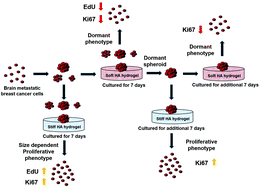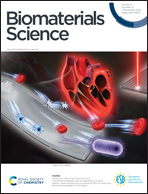Matrix stiffness and cluster size collectively regulate dormancy versus proliferation in brain metastatic breast cancer cell clusters†
Abstract
Breast cancer cells can metastasize either as single cells or as clusters to distant organs from the primary tumor site. Cell clusters have been shown to possess higher metastatic potential compared to single cells. The organ microenvironment is critical in regulating the ultimate phenotype, specifically, the dormant versus proliferative phenotypes, of these clusters. In the context of breast cancer brain metastasis (BCBM), tumor cell cluster–organ microenvironment interactions are not well understood, in part, due to the lack of suitable biomimetic in vitro models. To address this need, herein, we report a biomaterial-based model, utilizing hyaluronic acid (HA) hydrogels with varying stiffnesses to mimic the brain microenvironment. Cell spheroids were used to mimic cell clusters. Using 100–10 000 MDA-MB-231Br BCBM cells, six different sizes of cell spheroids were prepared to study the impact of cluster size on dormancy. On soft HA hydrogels (∼0.4 kPa), irrespective of spheroid size, all cell spheroids attained a dormant phenotype, whereas on stiff HA hydrogels (∼4.5 kPa), size dependent switch between the dormant and proliferative phenotypes was noted (i.e., proliferative phenotype ≥5000 cell clusters < dormant phenotype), as tested via EdU and Ki67 staining. Furthermore, we demonstrated that the matrix stiffness driven dormancy was reversible. Such biomaterial systems provide useful tools to probe cell cluster–matrix interactions in BCBM.



 Please wait while we load your content...
Please wait while we load your content...